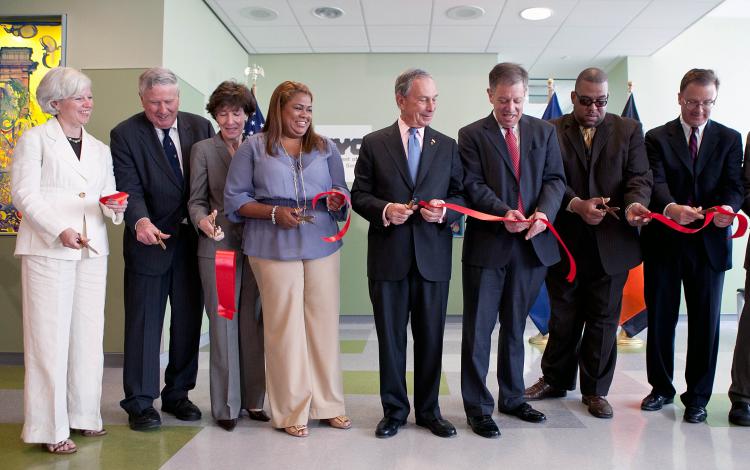NEW YORK—After eight years of planning and development, the city marked the opening of a new intake center for homeless families with a ribbon-cutting ceremony on Wednesday. The new shelter boasts high-tech features, increased space, and better service provisions. It has replaced an outdated facility.
The new center, named Prevention, Assistance, and Temporary Housing (PATH), is more than twice the size of its predecessor, the Emergency Assistance Unit (EAU). Over 200 professionals from relevant city offices are on-site to service homeless families and pregnant women.
The PATH facility, located at 151 E. 151st St. in the Bronx, opened on May 3 and is operational 24 hours a day, 7 days a week. It is currently the only Department of Homeless Services’ intake facility for families with children.
“The new Prevention Assistance and Temporary Housing facility was designed to provide compassionate and efficient services that had not previously been offered by the city,” stated Mayor Michael Bloomberg in a press release. “When I first saw the Emergency Assistance Unit in 2003, I was appalled,” he added.
The opening of the new center is a part of an eight-year effort by the city to improve services for the homeless. The Family Homelessness Special Master Panel was formed in 2003 to study and propose improvements to the city’s family shelter system. The panel’s recommendations led to implementation of policies to better integrate homeless families back into to the community. Among the successes of the process are the same-day placement and a shortened intake time, from roughly 20 hours to 6 hours per family.
The Department of Homeless Services puts emphasis on prevention of homelessness. It operates 13 offices, where people at-risk for homelessness can seek help to develop long-term housing stability strategies. Meanwhile, homeless families arriving at a shelter are required to develop an Independent Living Plan, which outlines family members’ expected participation in employment training, job search programs, rehabilitative services, and apartment search activities.
Homeless advocates have criticized the city’s homeless policy, saying that it is bureaucratic and that it unjustly denies shelter to many people in need. According to a briefing paper by the Coalition for the Homeless dated May 2, a record number of homeless people were found ineligible for shelter services during 2010.
The coalition welcomed the opening of the new PATH facility, calling it “a welcome improvement over the notorious old center,” but warned that the situation will not improve without tackling core system-wide problems.
“The new building stands as evidence of the city’s ongoing commitment to homeless families,” stated Gail B. Nayowith, executive director of SCO Family of Services and former member of the Special Master Panel. “We finally have a space that was built to handle and process the near-constant flow of families seeking shelter.”
“Fifteen years ago, I found myself coming to the old EAU,” shared councilwoman Annabel Palma, who had been homeless. “I didn’t even walk into the door.” The conditions in the old facility were so harsh that she didn’t want to take her 3-year-old son there.
“When people walk into a place looking for help, they don’t want to be de-humanized,” Palma said. “The old building did that to people like me and people in my community.”
“I applaud this administration for recognizing that if you are homeless it does not mean you mean less, that you deserve a chance in life. The new building will give them [the homeless] just that,” she concluded.
The new center, named Prevention, Assistance, and Temporary Housing (PATH), is more than twice the size of its predecessor, the Emergency Assistance Unit (EAU). Over 200 professionals from relevant city offices are on-site to service homeless families and pregnant women.
The PATH facility, located at 151 E. 151st St. in the Bronx, opened on May 3 and is operational 24 hours a day, 7 days a week. It is currently the only Department of Homeless Services’ intake facility for families with children.
“The new Prevention Assistance and Temporary Housing facility was designed to provide compassionate and efficient services that had not previously been offered by the city,” stated Mayor Michael Bloomberg in a press release. “When I first saw the Emergency Assistance Unit in 2003, I was appalled,” he added.
The opening of the new center is a part of an eight-year effort by the city to improve services for the homeless. The Family Homelessness Special Master Panel was formed in 2003 to study and propose improvements to the city’s family shelter system. The panel’s recommendations led to implementation of policies to better integrate homeless families back into to the community. Among the successes of the process are the same-day placement and a shortened intake time, from roughly 20 hours to 6 hours per family.
The Department of Homeless Services puts emphasis on prevention of homelessness. It operates 13 offices, where people at-risk for homelessness can seek help to develop long-term housing stability strategies. Meanwhile, homeless families arriving at a shelter are required to develop an Independent Living Plan, which outlines family members’ expected participation in employment training, job search programs, rehabilitative services, and apartment search activities.
Homeless advocates have criticized the city’s homeless policy, saying that it is bureaucratic and that it unjustly denies shelter to many people in need. According to a briefing paper by the Coalition for the Homeless dated May 2, a record number of homeless people were found ineligible for shelter services during 2010.
The coalition welcomed the opening of the new PATH facility, calling it “a welcome improvement over the notorious old center,” but warned that the situation will not improve without tackling core system-wide problems.
“The new building stands as evidence of the city’s ongoing commitment to homeless families,” stated Gail B. Nayowith, executive director of SCO Family of Services and former member of the Special Master Panel. “We finally have a space that was built to handle and process the near-constant flow of families seeking shelter.”
“Fifteen years ago, I found myself coming to the old EAU,” shared councilwoman Annabel Palma, who had been homeless. “I didn’t even walk into the door.” The conditions in the old facility were so harsh that she didn’t want to take her 3-year-old son there.
“When people walk into a place looking for help, they don’t want to be de-humanized,” Palma said. “The old building did that to people like me and people in my community.”
“I applaud this administration for recognizing that if you are homeless it does not mean you mean less, that you deserve a chance in life. The new building will give them [the homeless] just that,” she concluded.






